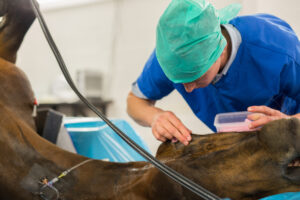Technology and results go hand-in-hand, or shall we say, “hand-in-paw,” when it comes to veterinary surgery. Thanks to new technology in veterinary medical devices, animals now have the best prognosis and shortest recovery times. This doesn’t just apply to companion animals, horses, and large animals. Exotic animals also benefit from technology.
The use of technology in the surgical room also makes life better for those that care for animals in need, too. Veterinary practitioners can now access devices and pharmaceuticals that make performing their jobs easier, more efficient and accurate, and most importantly, more effective.
Yet this brief overview just skims the surface of the fascinating world of tech in the operating room. To shine a light on the amazing breakthroughs in veterinary science, this article will dive into the ins and outs of the latest surgical tool and tech that vets now use.
Why Technology is a Must in Veterinary Medicine
It may seem that every time you look at the veterinary news, there is a new outbreak or discovery regarding disorders. Why is that? Because we’re constantly discovery more and more about animal health. Which is great because we cannot treat or cure what we do not know exists. This is where tech comes in. Technology in veterinary medicine allows practitioners to stay on top of the latest discoveries and respond with the best approach.
When you can use the most effective diagnostics and the most minimally invasive instruments, animals win.
How Has Technology Evolved in Animal Healthcare?
If a vet practicing decades ago walked into a modern vet practice today, they may feel as if they were walking into a sci/fi scene from The Twilight Zone. With lasers, anxiety halos, and AI devices connected to patients, it’s hard to blame them. It was just years ago that most veterinary surgeries were performed after one quick injection of the anesthetic, pentobarbital [1]. And the primary tool for internal diagnostics was the X-ray. Needless to say, veterinary medicine looks completely different than it did just ten years ago.
What are some of the forms of technology that have risen in popularity in recent years? The most technologically advanced practices now use:
- AI diagnostics and wearable monitoring devices[1]
- Ultrasound machines
- MRIs
- Therapeutic lasers [2]
- Highly detailed digital imaging [3]
- Rapid-response, in-house testing
- More precise operating tools with built-in suction, navigation, and intraoperative tissue collection
- Targeted pulsed electromagnetic field devices
- 3D printers connected to tomography scanners
- Cameras that can be ingested as pills
- And smartphone apps for patient records, real-time data, and mor
How Has New Veterinary Surgical Technology Changed the Industry?
As the popularity of pets and other animal ownership increases, the bond people have with their animals strengthens. This bond directly correlates with how invested pet owners are in providing their pets with the best veterinary care–and the best quality of life. The result is a highly competitive industry where vet practices seek the latest technology and the most advanced approaches, in order to provide their clients with better care.
Technology has a net positive impact on pets’ lives and wellbeing with:
- More accurate diagnostics
- More precise, less invasive surgery with fewer complications
- Faster recovery
- Better pain management
Tech in the Veterinary OR
As for the OR, veterinary surgeons have always been the first adopters of technology. And it’s easy to understand why. Surgery requires technical precision, and it can take a major toll on a vet’s body over time. Surgery is also one of the most stressful procedures in the eyes of pet owners.
There are few regions of a veterinary hospital where technology has had more of an impact than in the OR. To begin, anesthesia is now safer and easier than ever with cutting-edge anaesthetic machines.
And when it comes to removing cancers, repairing ligaments, or even cesarean section, vets now have more control than ever before. With greater control, vets can spend less time in physical discomfort while their patients spend less time under anesthesia. Veterinary surgeons can make precise margins when tumors are removed, resulting in less damage to adjacent tissues and less scar tissue. They can also collect biopsies during the surgical process [5].
Veterinary Surgical Equipment Has Become More Affordable
While the science behind veterinary surgical instruments and tools has become more sophisticated, the price of these tools has shrunk. The drop in price is thanks to more cost-effective manufacturing technology. The lower cost of making tools transfers to saving for veterinary clinics. Now, more vets can access the tools they need to provide every four-legged patient that walks through their doors with the most accurate and effective care.
We Look Forward to the Future of Veterinary Medical Devices
We marvel at how greatly technology improves the lives of vets, people, and animals. From the surgical suite to being able to find a lost pet, we know that technology has earned its keep in the hearts of pet owners and pet healthcare workers. And rightfully so. As more studies take place in veterinary science, we will continue to celebrate faster recovery times, heightened surgical precision, safer anesthesia, and better pain management for pets and large animals.
We look forward to providing manufacturers of novel veterinary equipment the opportunity to enter the animal health market. If you want to learn more about how you can get your medical device into the hands of vets, please contact us to discover how to help provide cutting-edge care.




